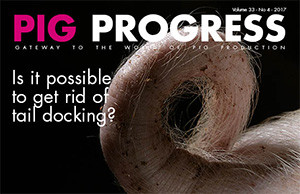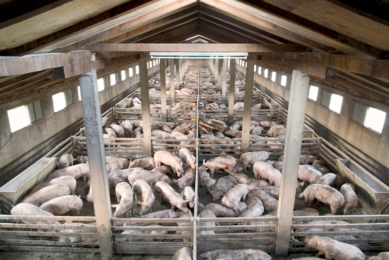4th issue of Pig Progress: Focus on nutrition and gut health

The cover picture shows an entire pig tail, yet most of the articles in the latest issue of Pig Progress do focus on pig nutrition as well as gut health.
First things first – the entire pig tail, what’s this all about? This spring, the international research consortium FareWellDock released an overview article in which the progress is described that the group did. It was started up as an initiative to get rid of tail docking in the United States – but in order to do so, it is necessary to understand the underlying problem of tail biting.
Researchers have come closer to deciphering how to avoid that. In this article, a general summary is presented, individual participating researchers will delve into the individual researches in future editions of Pig Progress. Pages 6-7.
Gut health: Algae & focus on the stomach
Which topics relate to gut health in this edition? Cassie Holloway of Olmix Animal Care in France takes a look at what algae can mean for controlling diarrhoea. Pigs have to be fed with macro-algae as from day 5 after birth, the company has seen promising results. Pages 9-11.

The functioning of the stomach is the key focus of a contribution by Wouter Naeyaert of Nuscience. If only the pig’s stomach could be kept functioning correctly, the entire gut will work better, is the line of his article. How to do that better than by providing good nutrition? Pages 13-14.
Nutrition: keeping pigs agile
Dr Gwendolyn Jones of Anco Animal Nutrition clearly can’t wait until the latest digital revolution is among us. She devoted some promising words on the Industry 4.0 movement to the developments of everything around us becoming ‘smart’ and ‘agile’ – so why not the pig business?

She speaks of agile nutrition concepts which eventually may be able to respond to nutritional stressors, like e.g. mycotoxins. Read more on pages 28-30.
Nutrition: better encapsulation
Austria-based feed additives manufacturer Biomin recently introduced an enhanced phytogenic concept which is about better encapsulation but also linked to better performance and optimised feed conversion. István Csutorás tells you all about it on pages 32-33.
Feed for antibiotic-free pork
A growing trend in Europe is to raise pigs without the use of antibiotics. In order to do so, the diets for the animals not only need to be void of antimicrobials, but be formulated in such a way that the pigs are likely not to suffer from diseases as well. David Guillou of Mixscience explains which key issues play an important role in this respect. Pages 36-37.

Feeding sows to enhance piglet livability
Marc Decoux of Cargill picked up where he left off in a previous edition and zooms in on how to enhance piglet livability by enhancing sow nutrition. There are various key stages in a sow’s breeding cycle that deserve a little bit extra attention. Page 38-39.
Taking a look at a farm in… Luxembourg
Our monthly farm visit takes us to one of the smallest countries in Europe: Luxembourg. It goes to show that that doesn’t have to be a disadvantage, as the health conditions at the farm are excellent. Read the story of Armand and Carine Kreins in an excellent contribution by correspondent René Stevens on pages 24-26.

How is swine production in… the Philippines?
This month’s pig country in focus is the Philippines – complex in itself with so many islands. Dr John Strak analyses strengths and weaknesses of this country which holds a lot of opportunities. Pages 16-18.
Columns on immunity and forgotten relationships
Regular columnist John Gadd zooms in this month on immunity and wonders how clean exactly is clean for pig farms? Page 20
In her column, Casey Bradley from AB Vista, wonders whether pig producers sometimes aren’t forgetting something. She’s not thinking of people, but rather about how minerals tend to interact between each other read more on page 42.
To read all the articles in this issue, go to the magazine overview page and sign up with your current website login.











